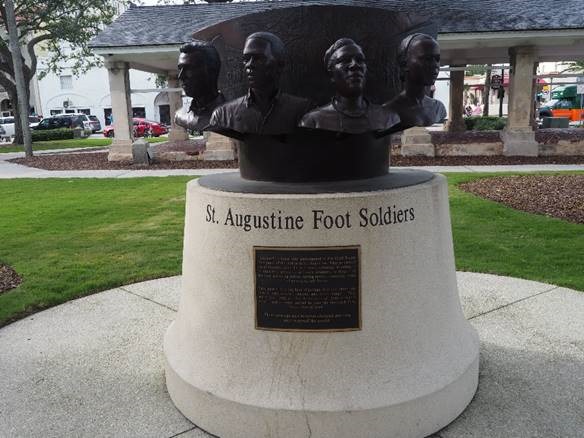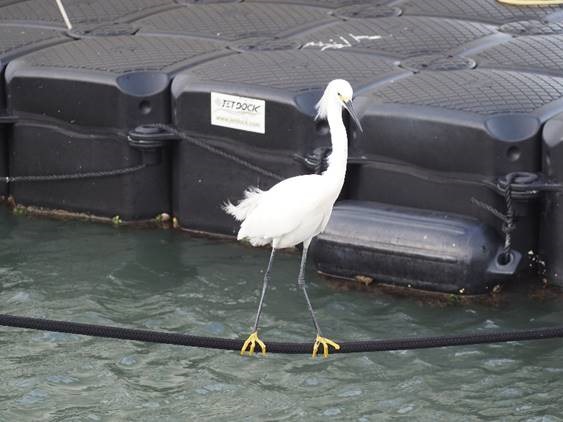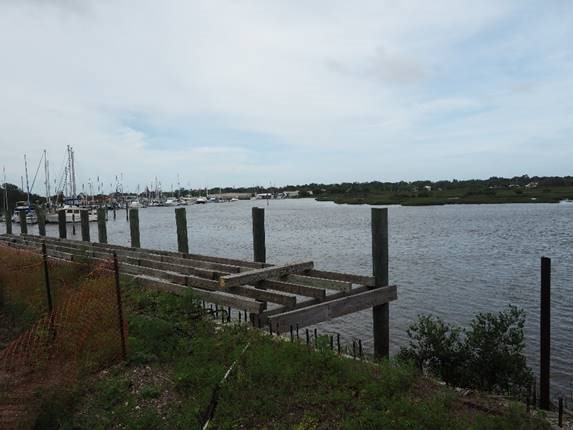26 May - Heading North along Florida's Atlantic coast

|
29:53.6N 081:18.6W We sailed from Key West at sunset, appropriately enough for the self-styled ‘home of the sunset’. It’s a great place; I think that its location right at the end of the Florida peninsula and then some, gives it an air of ‘devil take the hindmost’ which is probably why people like Hemingway and Tennessee Williams found peace there. A community reliant on the sea, formed from shipwreck survivors, people running from something, entrepreneurs in love with the climate, far enough from the Establishment of the East Coast, but still definitively American…
The southernmost point of USA, unless you’re in the military! With the wind in the south east and an easterly course for the first hundred miles or so, we decided to push offshore initially as we didn’t want to get tangled up in the shallow water around the Keys in the dark with thunderstorms about. Then we hit the Gulf Stream, which picked us up and carried us eastwards at about three knots. It was exactly where the US Met Office, NOAA, said it would be. It gave us terrific momentum and in no time we were making nine knots over the ground. We stayed on port tack until midnight, by which time we had made enough ground to the south to be able to tack and clear the south east corner of Florida completely. The wind was quite strong and the combination of wind over tide made the sea pretty rough, but the boat was coping well. Unusually, we were slamming a bit, which you might expect in a light displacement craft but is very rare in the Oyster, so we put plenty of reefs in for the Middle Watch to ease some of the strain on boat and rigging, whilst the current continued to sluice us to the east. By Monday lunchtime we were off Key Largo and eased the sheets and shook out a couple of reefs as we turned onto a more northerly course towards Miami. We shot past that huge skyscraper skyline at teatime and by sunset were off Palm Beach and heading for Cape Canaveral, averaging over ten knots over the ground. Halfway through the Middle Watch on Tuesday morning, the Gulf Stream suddenly deserted us. I came to starboard to try to reconnect, but when we were about forty degrees off course and still not in it, we had to accept that it had headed off towards Northern Europe and we would have to make our own way to St Augustine! The wind dropped during Julie’s watch, which didn’t bother us too much as we had made so much ground in the previous 36 hours that we needed to slow down a fair bit in order to arrive off the harbour entrance in daylight. With hindsight, we overcorrected a bit, because much later in the day, with the wind down below ten knots we had to start the engine to maintain enough speed – the entrance to St Augustine has a big sandbar and I didn’t want to go in at Low Water! Still, we had dolphins to keep us company and the thunderstorms of the last few days were diminishing in duration and intensity as the days passed. We reached the mouth of the Matanzas River, the entrance to St Augustine, at dawn on Wednesday. The tide was ebbing and the narrow gap between low lying islands looked a little uninviting: big surf either side of a fast flowing channel with huge dredging pipes strewn across the fairway. We found 4m depth at the entrance, some three miles from the harbour and I was wondering if this was all going to be for nothing, when the depth increased to 8m and then 12m. The navigation buoys were not where the chart thought they were, but it was clear that this is a well-maintained channel used by quite significant local and commercial traffic, so we pushed on in without incident.
Almost in – the city of St Augustine, a dredger and the entrance to the Matanzas River The harbour at St Augustine is part of the Intracoastal Waterway (ICW), a remarkable natural feature which allows boats with fairly shallow draft and masts under 65’ to sail all the way from the Chesapeake to Key West without ever going into the Atlantic. Needless to say, Escapade is too deep draft (2.3m) and the mast is too tall (65’6”), but we can take advantage of a number of inlets such as this to find a safe haven and come ashore. The ICW is busy with motor boats and yachts all year round, not to mention the hundreds of local boats which enjoy ‘gunkholing’ and fishing all along this fascinating coast and the odd tug and tow taking raw materials up the many rivers that form the Florida, Georgia and Carolina landscapes. We picked up a mooring buoy run by the St Augustine Municipal Marina and got our heads down for a few hours. At lunchtime, we ventured ashore. Founded by the Spanish in 1565, this is the oldest continuously occupied European settlement in the US. It was sacked by Sir Francis Drake (a previous Commander of the Devonport Flotilla?), ruled by the British for a while, ceded back to Spain in the early 1800s and finally came under US ownership in 1821. Towards the end of the century, Henry Flagler arrived and his vision for Florida was conceived here; for a while it was the epicentre of upper class vacationing until his railway took people further south. More recently, St Augustine played a prominent role in the Civil Rights struggles of the 1960s. It was the only place in Florida where Martin Luther King was arrested. In the subsequent violence, some black protesters jumped into a whites-only swimming pool, whereupon the manager poured hydrochloric acid into the water to burn them. Can you believe it? Today, only around 10% of the population is black…
Civil Rights memorial, St Augustine For most Americans, this is a place of huge historical significance. Quite a bit of the town has been restored and preserved to show off the colonial architecture. The fort looks like any of the Spanish or Portuguese fortifications protecting the Douro, the Tagus or the Guadalquivir. The most striking buildings are more modern though: they were built by Flagler and his friends to replicate the fine Spanish palaces they had seen on their European travels, but instead of Moorish artesans they employed a new technique: poured concrete and ‘ferro-cement’. The result is unusual: from a distance, the major buildings in the centre of town are quite impressive, but when you get up close, they look increasingly shoddy. Cracks and crumbling concrete, plus the distinct lines caused by the wooden frames that held the concrete as it set. They were pioneering buildings at the time and very splendid inside.
The Spanish fort dates from 1565. Quite old, then! The biggest, the Hotel Ponce de Leon (named after a Spanish adventurer who was looking for the Fountain of Youth and whose name appears all over this part of Florida) was a marvel in its day. The interior is still a work of art, but as it is now the centrepiece of the Flagler University, we could not see much of it. The main courtyard reminded us of the Plaza de Europa in Seville, built in the 1920s (see Blog entry 22 Sept 2017), but for me the whole atmosphere was irreparably besmirched by the continuous bellringing from the towers: a saccharine selection of Beatles and Eagles tunes pushed out on a loop by some deaf electro-whizz campanologist. Utterly appalling!
Central courtyard of Flagler University, with one of the offending bell towers The town itself did not seem quite real. The sidewalks are immaculate, but the shops are aimed fair and square at tourists and wedding parties (this is a very popular place to get married – after all, you are surrounded by ‘history’, so why not make your special day part of it?). Art galleries and bling jewellery vie with Chinese-made Spanish souvenirs showing Drake as a murdering pirate. There’s a delicious irony that modern day Florida is a popular destination for elderly folk who, like good old Ponce, are still looking for the Fountain of Youth…
Check out my yellow wellies! After lunch, we went in search of a chandlery and some minor food shopping. To do this, we had to catch a bus. Buses are not common in these parts, after all, just about everyone has a truck – or at least some personal relationship with the automobile. Accordingly, the rather infrequent bus service is operated as a charity for the seriously down and out – and the Escapaders. I think we might have been the only people on the bus who were required to pay – and it was only a dollar! The West Marine store (part of a massive chain of chandleries spread across the US) was rather focused on fishing, so it was not surprising that they did not stock 24v navigation lights for vessels over 10m. However, they told us about a secondhand shop a few blocks away and a more specialist chandlery back towards town. We walked. Not many people walk here and given the oppressive heat, I’m not surprised. The secondhand shop was a massive Aladdin’s Cave with a handful of rather dodgy 24v lights, but more importantly a reasonable selection of pilot books covering the waters north of Florida (West Marine only sold books on Florida and we are about to enter Georgia…). We picked up a couple of reasonably recent volumes covering waters as far as Delaware and retreated to a café next door to replenish liquids and phone Lizzie at home in England.
Now a museum, but formerly a private home modelled out of concrete on the Alcazar in Seville… As we sat in the café, an armed Police holdup unfolded a few yards away across the street. Over the space of half a minute, six large cop cars screeched to a halt outside and a dozen heavily armed policemen took up classic Hollywood poses around a solitary purple 1980s Datsun parked outside a beauty salon. The two occupants were black. I guess they sensed that cooperation was the best course of action and the excitement dissipated fairly rapidly as they were unceremoniously extracted from the Datsun, pinned to the tarmac and then inserted headfirst into a couple of police cars. No shots were fired and after some other policemen turned up to examine the car, life returned to normal. At least it did for us; I’m not sure the two occupants are having as much fun… We found the navigation lights in a huge, deserted chandlery back towards town. We stopped in a ‘local farm shop’ because it seemed so incongruous in this landscape. Inside, the promising exterior gave way to more boutique-style emporia selling things you never knew you needed, but we did come away with some smart new wooden spoons and some excellent, if expensive bananas.
St Augustine backwater That evening, we found a wonderful little cinema showing current ‘arthouse’ movies, so rearranged our day to watch ‘Lean on Pete’ in a couple of armchairs, sipping wine and eating snacks, all for just a few dollars. On Thursday, I fitted the new navigation lights (the port one had been damaged for a while and finally carried away in the rough seas off Key West a couple of days earlier) whilst Julie was ashore doing chores. That evening, we returned to the cinema to watch ‘Keep the Change’, a disturbing but uplifting drama about Autism. We need to find more cinemas like this: such a personal, civilised experience compared to the mass-produced popcorn-rich glitz of the modern multiplex.
‘Freedom’ sailing through the bascule bridge ‘Bridge of Lions’ at St Augustine On Friday, the world changed. Julie’s mum was taken seriously ill and now in a Milan hospital. Julie’s sister Meriel was with her (they had gone to see an opera at La Scala as a treat), her elder sister Susan was looking for a flight and I spent the morning doing the same thing. It was a Bank Holiday in England and it appeared every man and his dog had decided to go to northern Italy for the weekend… but eventually we found a flight from Orlando to Manchester, a train to London, an overnight stop with Lizzie on the South Bank and then a flight to Milan on Sunday. We found the last hire car in Florida down Highway One just south of Augustine and by midday were on our way to Orlando. Julie got the flight with plenty of time to spare and I had the opportunity to catch up with our older daughter Anna, who was holidaying with her boyfriend Matt and his family at the theme parks in Orlando. We had dinner together at Universal Studios and I drove back to St Augustine, getting back onboard the boat at about midnight. What next? Granny’s condition is quite serious and it is unlikely that Julie will be returning to Escapade on the next flight to Orlando. We need to get the boat north of Cape Hatteras by the end of June, so I will ‘day sail’ along the coasts of Georgia, South and North Carolina, picking the weather and the tides. Next task: find a crew to help with the longer passage around the Cape… |








